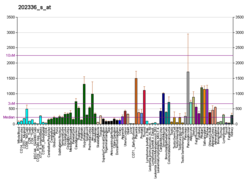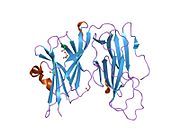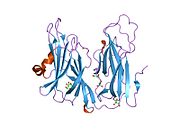Peptidylglycine alpha-amidating monooxygenase
 From Wikipedia the free encyclopedia
From Wikipedia the free encyclopedia
Peptidyl-glycine alpha-amidating monooxygenase, or PAM, is an enzyme that catalyzes the conversion of an n+1 residue long peptide with a C-terminal glycine into an n-residue peptide with a terminal amide group. In the process, one molecule of O2 is consumed and the glycine residue is removed from the peptide and converted to glyoxylic acid.[5]
The enzyme is involved in the biosynthesis of many signaling peptides and some fatty acid amides.[6]
In humans, the enzyme is encoded by the PAM gene.[7][8] This transformation is achieved by conversion of a prohormone to the corresponding amide (C(=O)NH2). This enzyme is the only known pathway for generating peptide amides. Replacing the carboxylic acid group with an amide group makes the peptide more hydrophobic and more likely to be neutrally charged at physiologic pH, and it is believed that these neutrally charged peptide amides can more easily bind to receptors.[5]
Function[edit]
This gene encodes a multifunctional protein. It has two enzymatically active domains with catalytic activities - peptidylglycine alpha-hydroxylating monooxygenase (PHM) and peptidyl-alpha-hydroxyglycine alpha-amidating lyase (PAL). These catalytic domains work sequentially to catalyze neuroendocrine peptides to active alpha-amidated products. The reaction pathway catalyzed by PAM is accessed via quantum tunneling and substrate preorganization.[9] Multiple alternatively spliced transcript variants encoding different isoforms have been described for this gene, but some of their full-length sequences are not yet known.[8]
The PHM subunit effects hydroxylation of a C-terminal glycine residue:
- peptide-C(O)NHCH2CO2− + O2 + 2 [H] → peptide-C(O)NHCH(OH)CO2− + H2O
This process shown above is the hydroxylation of a methylene group (-CH2-) by O2, and this process relies on a copper ion cofactor. Dopamine beta-hydroxylase, also a copper-containing enzyme, effects a similar transformation.[10]
The PAL subunit then completes the conversion, by catalyzing elimination from the hydroxylated glycine:
- peptide-C(O)NHCH(OH)CO2− → peptide-C(O)NH2 + CH(O)CO2−
The eliminated coproduct is glyoxylate, written above as CH(O)CO2−.
In insects[edit]
Insect PαAMs are responsive to O2 concentrations and depends upon Cu2+. Simpson et al 2015 finds insect PαAMs to respond to hypoxia by regulating the activity of several peptide hormones. They find PαAM to probably be an important part of neuroendocrine responses to hypoxia.[11]
References[edit]
- ^ a b c GRCh38: Ensembl release 89: ENSG00000145730 – Ensembl, May 2017
- ^ a b c GRCm38: Ensembl release 89: ENSMUSG00000026335 – Ensembl, May 2017
- ^ "Human PubMed Reference:". National Center for Biotechnology Information, U.S. National Library of Medicine.
- ^ "Mouse PubMed Reference:". National Center for Biotechnology Information, U.S. National Library of Medicine.
- ^ a b Eipper BA, Milgram SL, Husten EJ, Yun HY, Mains RE (April 1993). "Peptidylglycine alpha-amidating monooxygenase: a multifunctional protein with catalytic, processing, and routing domains". Protein Science. 2 (4): 489–497. doi:10.1002/pro.5560020401. PMC 2142366. PMID 8518727.
- ^ Wilcox BJ, Ritenour-Rodgers KJ, Asser AS, Baumgart LE, Baumgart MA, Boger DL, et al. (March 1999). "N-acylglycine amidation: implications for the biosynthesis of fatty acid primary amides". Biochemistry. 38 (11): 3235–3245. doi:10.1021/bi982255j. PMID 10079066.
- ^ Glauder J, Ragg H, Rauch J, Engels JW (June 1990). "Human peptidylglycine alpha-amidating monooxygenase: cDNA, cloning and functional expression of a truncated form in COS cells". Biochemical and Biophysical Research Communications. 169 (2): 551–558. doi:10.1016/0006-291X(90)90366-U. PMID 2357221.
- ^ a b "Entrez Gene: PAM peptidylglycine alpha-amidating monooxygenase".
- ^ McIntyre NR, Lowe EW, Belof JL, Ivkovic M, Shafer J, Space B, Merkler DJ (November 2010). "Evidence for substrate preorganization in the peptidylglycine α-amidating monooxygenase reaction describing the contribution of ground state structure to hydrogen tunneling". Journal of the American Chemical Society. 132 (46): 16393–16402. doi:10.1021/ja1019194. PMC 2988104. PMID 21043511.
- ^ Abad E, Rommel JB, Kästner J (May 2014). "Reaction mechanism of the bicopper enzyme peptidylglycine α-hydroxylating monooxygenase". The Journal of Biological Chemistry. 289 (20): 13726–13738. doi:10.1074/jbc.M114.558494. PMC 4022847. PMID 24668808.
- ^ Harrison JF, Greenlee KJ, Verberk WC (January 2018). "Functional Hypoxia in Insects: Definition, Assessment, and Consequences for Physiology, Ecology, and Evolution". Annual Review of Entomology. 63 (1). Annual Reviews: 303–325. doi:10.1146/annurev-ento-020117-043145. hdl:2066/193219. PMID 28992421.
Further reading[edit]
- Pittner RA, Albrandt K, Beaumont K, Gaeta LS, Koda JE, Moore CX, et al. (1994). "Molecular physiology of amylin". Journal of Cellular Biochemistry. 55 (S1994A): 19–28. doi:10.1002/jcb.240550004. PMID 7929615. S2CID 35842871.
- Ouafik LH, Stoffers DA, Campbell TA, Johnson RC, Bloomquist BT, Mains RE, Eipper BA (October 1992). "The multifunctional peptidylglycine alpha-amidating monooxygenase gene: exon/intron organization of catalytic, processing, and routing domains". Molecular Endocrinology. 6 (10): 1571–1584. doi:10.1210/mend.6.10.1448112. PMID 1448112.
- Maltese JY, Eipper BA (December 1992). "Developmental expression of peptidylglycine alpha-amidating monooxygenase (PAM) in primary cultures of neonatal rat cardiocytes: a model for studying regulation of PAM expression in the rat heart". Molecular Endocrinology. 6 (12): 1998–2008. doi:10.1210/mend.6.12.1491686. PMID 1491686.
- Braas KM, Harakall SA, Ouafik L, Eipper BA, May V (May 1992). "Expression of peptidylglycine alpha-amidating monooxygenase: an in situ hybridization and immunocytochemical study". Endocrinology. 130 (5): 2778–2788. doi:10.1210/endo.130.5.1572293. PMID 1572293.
- Roberts AN, Leighton B, Todd JA, Cockburn D, Schofield PN, Sutton R, et al. (December 1989). "Molecular and functional characterization of amylin, a peptide associated with type 2 diabetes mellitus". Proceedings of the National Academy of Sciences of the United States of America. 86 (24): 9662–9666. Bibcode:1989PNAS...86.9662R. doi:10.1073/pnas.86.24.9662. PMC 298561. PMID 2690069.
- Vos MD, Jones JE, Treston AM (October 1995). "Human peptidylglycine alpha-amidating monooxygenase transcripts derived by alternative mRNA splicing of an unreported exon". Gene. 163 (2): 307–311. doi:10.1016/0378-1119(95)00364-C. PMID 7590286.
- Tsukamoto T, Noguchi M, Kayama H, Watanabe T, Asoh T, Yamamoto T (April 1995). "Increased peptidylglycine alpha-amidating monooxygenase activity in cerebrospinal fluid of patients with multiple sclerosis". Internal Medicine. 34 (4): 229–232. doi:10.2169/internalmedicine.34.229. PMID 7606087.
- Yun HY, Johnson RC, Mains RE, Eipper BA (February 1993). "Topological switching of the COOH-terminal domain of peptidylglycine alpha-amidating monooxygenase by alternative RNA splicing". Archives of Biochemistry and Biophysics. 301 (1): 77–84. doi:10.1006/abbi.1993.1117. PMID 7680192.
- Mains RE, Milgram SL, Keutmann HT, Eipper BA (January 1995). "The NH2-terminal proregion of peptidylglycine alpha-amidating monooxygenase facilitates the secretion of soluble proteins". Molecular Endocrinology. 9 (1): 3–13. doi:10.1210/mend.9.1.7760848. PMID 7760848.
- Tateishi K, Arakawa F, Misumi Y, Treston AM, Vos M, Matsuoka Y (November 1994). "Isolation and functional expression of human pancreatic peptidylglycine alpha-amidating monooxygenase". Biochemical and Biophysical Research Communications. 205 (1): 282–290. doi:10.1006/bbrc.1994.2662. PMID 7999037.
- Martínez A, Montuenga LM, Springall DR, Treston A, Cuttitta F, Polak JM (March 1993). "Immunocytochemical localization of peptidylglycine alpha-amidating monooxygenase enzymes (PAM) in human endocrine pancreas". The Journal of Histochemistry and Cytochemistry. 41 (3): 375–380. doi:10.1177/41.3.8094086. hdl:10171/20127. PMID 8094086.
- Kapuscinski M, Green M, Sinha SN, Shepherd JJ, Shulkes A (July 1993). "Peptide alpha-amidation activity in human plasma: relationship to gastrin processing". Clinical Endocrinology. 39 (1): 51–58. doi:10.1111/j.1365-2265.1993.tb01750.x. PMID 8102327. S2CID 72764842.
- Yun HY, Keutmann HT, Eipper BA (April 1994). "Alternative splicing governs sulfation of tyrosine or oligosaccharide on peptidylglycine alpha-amidating monooxygenase". The Journal of Biological Chemistry. 269 (14): 10946–10955. doi:10.1016/S0021-9258(17)34149-2. PMID 8144680.
- Ouafik LH, Mattei MG, Giraud P, Oliver C, Eipper BA, Mains RE (November 1993). "Localization of the gene encoding peptidylglycine alpha-amidating monooxygenase (PAM) to human chromosome 5q14-5q21". Genomics. 18 (2): 319–321. doi:10.1006/geno.1993.1471. PMID 8288234.
- Husten EJ, Tausk FA, Keutmann HT, Eipper BA (May 1993). "Use of endoproteases to identify catalytic domains, linker regions, and functional interactions in soluble peptidylglycine alpha-amidating monooxygenase". The Journal of Biological Chemistry. 268 (13): 9709–9717. doi:10.1016/S0021-9258(18)98406-1. PMID 8486658.
- Yun HY, Milgram SL, Keutmann HT, Eipper BA (December 1995). "Phosphorylation of the cytosolic domain of peptidylglycine alpha-amidating monooxygenase". The Journal of Biological Chemistry. 270 (50): 30075–30083. doi:10.1074/jbc.270.50.30075. PMID 8530412.
- Morris KM, Cao F, Onagi H, Altamore TM, Gamble AB, Easton CJ (December 2012). "Prohormone-substrate peptide sequence recognition by peptidylglycine α-amidating monooxygenase and its reflection in increased glycolate inhibitor potency". Bioorganic & Medicinal Chemistry Letters. 22 (23): 7015–7018. doi:10.1016/j.bmcl.2012.10.004. PMID 23084901.















